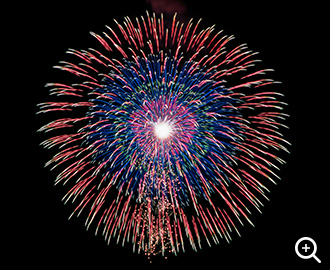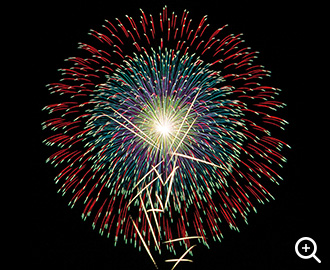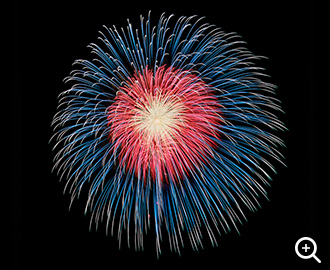It is said that the first person to view fireworks in Japan was Tokugawa Ieyasu, and since that time Mikawa City in Aichi Prefecture has been an area where fireworks events are prevalent. In addition, the fireworks manufacturing industry in Akita, Miyagi, Fukushima, Ibaraki, Niigata, Yamanashi, Nagano, Tokyo, Kanagawa, Shizuoka, Fukuoka, Oita, Kagoshima, and other parts of Japan has been developed to the present day with the support of a long history and tradition. On the other hand, it is said that the origin of the fireworks display, which has now become a popular entertainment event, is the "Ryogoku Kawakai (two countries) fireworks display," which was held in 1733, the year before this event. In the year before that, 1732, there was a massive famine and plague that killed many people throughout Japan. Tokugawa Yoshimune held the Suijin Matsuri festival on the day of the opening of the Kawakawa River to console the spirits of the dead and to pray for the prevention of the spread of the plague. As a result, the Kawakai Fireworks Festival was held every year on this day, which eventually became the Sumida River Fireworks Festival. The name of the fireworks master who made a big splash at the first fireworks display was "Keiya Yabei," but later a fireworks master started his own business from Keiya, named it "Tamaya Ichibei," and it grew to be a huge success in the Edo area, and it is said that this is the slogan that people shouted when they watched the fireworks. It is said that this is the origin of the slogan "Tamaya ~" and "Keiya ~" that people use when watching fireworks.
The size of the firework shell and the height of the firework when it is launched
| Number | Outer diameter (cm) | Height of fireworks (m) | Diameter when the firework is in bloom (m) |
|---|---|---|---|
| 2.5 | 6.9 | 80 | 50 |
| 3 | 8.6 | 120 | 100 |
| 4 | 11.5 | 150 | 120 |
| 5 | 14.4 | 200 | 150 |
| 6 | 17.3 | 220 | 180 |
| 7 | 20.2 | 250 | 200 |
| 8 | 23.0 | 280 | 250 |
| 10 (one foot of fireworks shells) | 28.5 | 300 | 280 |
| 20 (two-foot firework shells) | 58.0 | 450 | 450 |
| 30 (three-foot fireworks shells) | 86.0 | 600 | 600 |
Structure of Fireworks
Each of the small luminous particles in a firework that glows in all directions is called a "bead". These beads are tightly and evenly packed inside the concentric bowl of the paper firework skin. A detonating charge is added to the inside to break up the beads, and then a fuse is attached. Finally, the finished fireworks shell is filled with gunpowder for launching, and the fireworks are loaded into the launching tube. When the firing charge is ignited, the fuse is also ignited and the fireworks are launched high into the air. When the fire on the fuse ignites the explosive charge, countless "bright beads" fly in all directions and blossom into a gigantic flower in the night sky.This article comes from: https://fireworkslit.com/Fireworkslit-https://fireworkslit.com/the-world-renowned-japanese-art-fireworks/
Characteristics of Japanese Fireworks
Although fireworks are produced and sold all over the world, not all fireworks are designed in the same way. Each country's fireworks have their own unique characteristics. Among them, Japanese fireworks are known to be highly artistic and outstanding because of their fine craftsmanship. There are 3 main features of Japanese fireworks.This article comes from: https://fireworkslit.com/Fireworkslit-https://fireworkslit.com/the-world-renowned-japanese-art-fireworks/
1. Tamanoha (Firework Seat)
Although there are differences in the height of fireworks depending on the number of fireworks, it is ideal for the fireworks to burst when they reach the highest point. Such fireworks are called "fireworks with precise seating".This article comes from: https://fireworkslit.com/Fireworkslit-https://fireworkslit.com/the-world-renowned-japanese-art-fireworks/
2. Basin and Shoulder (Basin Shape and Open Shoulder)
The diameter of a firework when it is released varies depending on the size of the projectile. If a firework reaches the desired maximum diameter for each number, it is called a "beautiful pot-shaped firework". In addition, when a firework is released, it is called a "beautiful open-shoulder firework" if the bright beads gathered in the firework radiate from the centre to the outside at the same distance and expand into a 360-degree sphere.This article comes from: https://fireworkslit.com/Fireworkslit-https://fireworkslit.com/the-world-renowned-japanese-art-fireworks/
3. Hidden extinction point
When a firework is in bloom, the "bright beads" inside the firework will burst and glow, and if these "bright beads" glow at the same time and disappear at the same time, it is called a "firework with a perfect hiding point". "The Japanese fireworks makers have been working for several years to create fireworks that have the perfect point of disappearance.This article comes from: https://fireworkslit.com/Fireworkslit-https://fireworkslit.com/the-world-renowned-japanese-art-fireworks/
Japanese fireworks masters have been studying and improving these three characteristics for generations, and are still honing their fireworks production techniques.This article comes from: https://fireworkslit.com/Fireworkslit-https://fireworkslit.com/the-world-renowned-japanese-art-fireworks/
Characteristics of fireworks set off in Japan (extracted from the 2017 edition of the Fireworks Primer produced by the Japan Fireworks Association, a public interest organisation)
Japanese fireworks, especially the most representative type of fireworks, "chrysanthemum-shaped fireworks with a wick," are known as the most elaborate and magnificent fireworks in the world, and the three most important characteristics of these fireworks are as follows.This article comes from: https://fireworkslit.com/Fireworkslit-https://fireworkslit.com/the-world-renowned-japanese-art-fireworks/
- 1. A large, neatly shaped sphere is created when the firework is launched.
- 2. Each of the bright beads that make up the petals of the firework has a colour change.
- 3. Double and triple cores can be stacked in concentric circles.
Japanese firework shells are spherical in shape, while European and American firework shells are basically cylindrical. The same applies to the shape of the bright beads added to the fireworks shells. Japanese ones are still spherical, while European and American ones are cylindrical. The bright beads in Japanese fireworks are just like the old Japanese candies, with each layer of gunpowder a different colour. In Europe and the United States, it is common practice to compress the gunpowder and then cure it.This article comes from: https://fireworkslit.com/Fireworkslit-https://fireworkslit.com/the-world-renowned-japanese-art-fireworks/
Japanese fireworks, as shown in the picture on the right, are made by arranging the glittering beads in a circle inside a spherical skin (container), filling the centre with break powder, and then sticking a few circles of strong paper around the outside of the skin to ensure that it is secure. As long as the balance between the power of the breaking powder in the centre and the paper around the skin is correct, the beads will be evenly dispersed into the air, creating a rounded firework. However, if the paper around the outer perimeter is not evenly affixed, the fireworks will not be able to present a round shape and will become out of shape and crooked. And cylindrical fireworks launched into the air, bright beads will not be scattered in all directions, and therefore can not bloom out of the round. Fireworks from Europe and the United States are rare in that they have a different colour scheme from that of Japanese fireworks, and they can be launched high in the air and bloom several times in a row. Although it is impossible to distinguish Japanese fireworks from European and American fireworks in terms of small-sized fireworks types, when comparing fireworks shells of size 5 (15cm) or larger, Japanese fireworks are superior in terms of their subtlety and magnificent presentation.This article comes from: https://fireworkslit.com/Fireworkslit-https://fireworkslit.com/the-world-renowned-japanese-art-fireworks/
In addition, Japanese fireworks masters make clever use of washi paper to complete the technique of making two or three concentric circles (fireworks with cores). The ability to make this ultimate beauty of harmony a reality by making the circles visible from any angle, as well as the brilliant colour changes and just the right points of invisibility and extinction, can be said to be the result of the unique Japanese aesthetics and craftsmanship. As the text says, this is the result of the blood, sweat and wisdom of countless fireworks masters, including our ancestors. Recently, Japanese fireworks masters are trying to challenge the challenge of creating fireworks with quadruple and quintuple cores, and their inquisitiveness for the art is never-ending.This article comes from: https://fireworkslit.com/Fireworkslit-https://fireworkslit.com/the-world-renowned-japanese-art-fireworks/
Source: http: //www.hanabi-jpa.jp/data/booklet.html
[Quadruple-core changing chrysanthemums] Red Valley Aoki Fireworks Shop (Nagano)
This is the ultimate in Japanese artistic fireworks using an exquisite technique of filling fireworks shells with four different quadruple cores. The combination of different bright beads in each core allows all the bright beads in the quadruple core to produce multiple changes in a single moment.
[Rising Silver Tree Flashing Kaleidoscope with Core] Isoya Fireworks Shop (Aichi)
A column of silver light like a tree trunk climbs into the air as the firework is launched, and a colourful flower blooms as it reaches its apex. In the middle is the sparkling core of the flower, which is connected to eight huge petals of eight colours, as brilliant as a kaleidoscope.
Rising Small Flower Five-Colour Dahlia] HOSOYA ENTERPRISES (Tokyo) Co.
As the fireworks are launched, small fireworks are released one after another from the bottom of the fireworks, and at the top of the fireworks, a five-coloured flower as bright and colourful as a dahlia blooms.
[Rising Spray Flower Quadruple Core Change Chrysanthemum] Nomura Flower Fire Industry
Each bright bead is neatly arranged and blooms to form a huge orb in the night sky, presenting a 360° all-round superb modelling beauty. The fireworks in full bloom change colours in an orderly fashion in a flickering flash, before fading into obscurity in the immaculate night sky. This unparalleled delicacy and transience is the unique beauty of Japanese fireworks.
[Hachibanchiku] Sugano Fireworks (Fukushima)
This is a firework with multiple wicks. The number of layers in its fireworks shells is very high, with eight, three, four, and five layers. The bright beads in each layer carry 2 to 3 colour changes, and when finally set off in the night sky, 6 to 12 colour changes can be seen in just a split second of about 2 seconds. These fireworks are a perfect example of the beauty of the world-renowned Japanese artistic fireworks.
Fireworks photo: Kiminari Onozato
烟花燃放,烟花采购,花炮咨询,可以联系我们:q1chen@163.com








评论